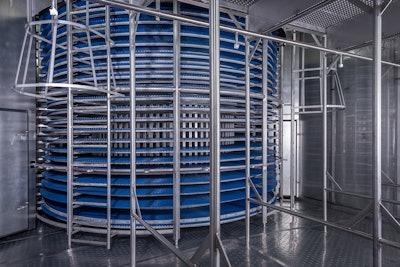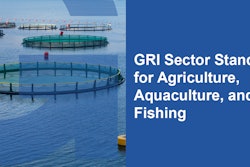
Those unfamiliar with industrial freezers and chillers will be surprised about the many aspects today’s designs bring to the food processing plant. From electronic sensors to remote access and maintenance, today’s technologies answer the call for improved food safety measures, both upstream and down.
Food Logistics chats with Greg Sheridan, sales manager for FPS Food Process Solutions Corp., to talk about freezers and chillers in the cold food space, what to consider when installing new equipment and what companies should be mindful of going forward.
Food Logistics: From your vantage point, what kinds of food safety advantages do freezers and chillers bring to the cold food space?
Greg Sheridan: The No. 1 cause of food spoilage is microbial activity. This type of activity is most active in the “danger zone” between 40°F-140°F where bacteria growth is exponentially higher in food processing operations. Chillers and freezers use engineered air flow at lower temperatures than normally used for storage to quickly strip heat from food, bringing it down to safe and even temperatures. By quickly bringing processed food down to temperatures lower than 40°F, this type of microbial activity is reduced or even stopped. Eliminating microbial activity not only prolongs the shelf life of the food, but also limits the growth of harmful microbials like mold and bacterium such as listeria and E-coli, which can cause serious illness and potentially death if ingested.
Food Logistics: On the flip side, what are some things to consider when installing or upgrading freezers and chillers?
Sheridan: People unfamiliar with industrial freezers and chillers are often surprised about the many aspects of this type of equipment. More often than not, the equipment itself is larger than anticipated, so space can be a concern. This is especially critical in existing plants, as there is often other equipment up and downstream from the freezer that needs to be considered in their overall planning. Upfront costs for procuring the freezing or chilling equipment can be higher than expected, but the costs for other associated equipment such as compressors needed to provide refrigeration to the unit are often a surprise. People are used to buying a refrigerator or freezer and just plugging it in as a self-contained unit. Industrial freezers aren’t as simple and generally require a separate refrigeration room built to house all the associated components.
When upgrading existing facilities, they also need to consider how to remove old equipment and bring in the new, including assembly. Equipment configurations and sizing is often different from existing units and this creates new challenges. There are usually changes to refrigeration piping, electrical panels and plant structure that also brings significant costs associated with them.
Food Logistics: What should companies be mindful of when it comes to maintaining freezers and chillers?
Sheridan: Different types of freezers and chillers for different types of food products will require varying levels of maintenance and cleaning to keep in top shape. Today’s modern equipment are engineered in order to minimize hard-to-clean spaces, which can harbor bacteria. These designs also reduce maintenance needs usually associated with older designed freezers and chillers. That being said, customers do have to learn that, like any equipment, it will perform better when properly operated and maintained.
Customers need to learn how their equipment runs over time and observe all the little things. Generally, running a freezer within the specifications should require a minimum amount of maintenance particularly when most electrical components are placed outside the unit. By running a freezer beyond its design specifications or not cleaning or maintaining it, can be very detrimental to freezer performance. It can also lead to product loss due to mechanical failure or food contamination, so adhering to the manufacturer’s specifications is important for long term performance and lower lifecycle costs.
Food Logistics: What kinds of technologies/solutions (i.e., Internet of Things, automation, etc.) do some of today’s freezers and chillers offer?
Sheridan: With the modernization of electronics, the controls side of freezing and chilling equipment has also advanced. Equipment now gives more feedback than ever before on motor operation and other sensors. This data is able to provide information, including operating optimization and capturing specific errors that was previously unavailable not long ago.
With improvements on the controls side, more advanced interfaces can record and store data such as logging cleaning schedules, temperatures and other items that may be used later for troubleshooting or safety audits.
With food processors popping up in different locations around the world, a customer may not be able to rely on service at a moments’ notice if something critical happens. With internet connectivity, manufacturers are now able to remotely access available data from the equipment and often troubleshoot remotely.
Remote access can also be used for fine tuning operations after commissioning crews have left the site. This is a huge benefit especially if travel is restricted, saving on costs as remote access can be done from anywhere in the world.
Advances in camera technology can also help customers and technicians to see what is happening inside the equipment without the safety concerns of actually being in the harsh environment. Cameras can also be accessed via tablets and phones for more mobile convenience and data can be recorded for viewing at a later time.
Food Logistics: What does the future of food safety look like? What should companies be doing now to ensure food safety in the future?
Sheridan: Food safety standards are becoming more and more strict in order to protect consumers. Old freezer designs are generally less efficient and more maintenance intensive than modern units, but also pose significant food safety risks. In recent years, food processors have begun to recognize the need for improved cleanliness and traceability in equipment. To mitigate the risk, they are purchasing more hygienically designed modern freezers and chillers.
Reducing and eliminating potential harborage points such as horizontal surfaces, square corners, lap joints, threads, hollow tubes, seals and caulking greatly reduces potential of foodborne illness. Modern freezers and chillers are carefully engineered to minimize these risky design features by using welding of material and joints and reducing internal surfaces and components that may catch debris.
Lastly, due to the inherent design of a modern freezer/chiller, the initial purchase cost is often higher when compared to outdated designed equipment, however, the reduced risk, ease of operation, lower maintenance and lower operating costs make a modern design the best choice when it comes to the lowest total cost of ownership.
Food Logistics: What are some things not addressed above that may be pertinent to our readers?
Sheridan: When looking at freezing and chilling equipment designed for industrial processing, try to find equipment that is holistically designed with all of its components. This will ensure that everything should be seamless. This is especially true when it comes to clean-in-place (CIP) systems. If a piece of equipment is not designed to be cleaned with an automated system, this will work very poorly, and ultimately, will not be cleaned properly. Holistic designs should be more user friendly for food processors.





![Adobe Stock 280800711 [converted]](https://img.foodlogistics.com/files/base/acbm/fl/image/2021/08/AdobeStock_280800711__Converted_.611e898daa123.png?auto=format%2Ccompress&fit=crop&h=167&q=70&rect=0%2C53%2C900%2C507&w=250)












